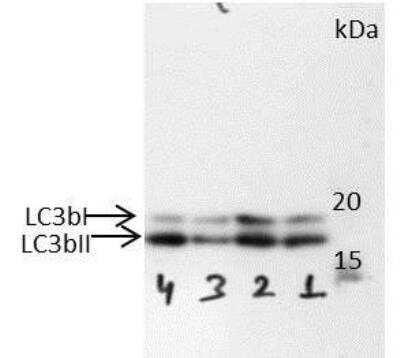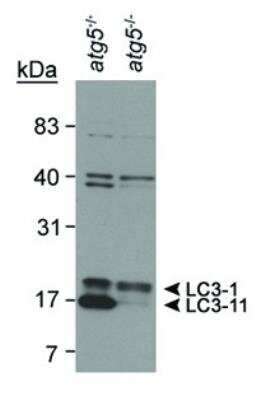LC3B Products
The Autophagin protein family is involved in autophagy, the biological process in which endogenous protein and damaged organelles are degraded. ATG3 (autophagy-related protein 3; also known as APG3-like and PC3-96) is a ubiquitous 45 kDa member of the ATG3 family of proteins. It functions as an E2-like enzyme during the initial stages of autophagosome formation by catalyzing the transfer of ATG7-bound ATG8 (also known as LC3, GATE16 and GABA-RAP in mammals) to phosphatidylethanolamine, critical for autophagy.
ATG4A (Autophagy related protein 4 homolog A; also known as Autophagin 2) is a 50 kDa cytosolic cysteine protease mostly found in skeletal muscle and brain. ATG10 (autophagy-related protein 10; also known as APG10-like) is a ubiquitous 28 kDa member of the ATG10 family of proteins. It serves as an E2-like enzyme during the initial stages of autophagosome formation by catalyzing the transfer of ATG12 to ATG5. This ATG5:ATG12 heterodimer subsequently associates noncovalently with an ATG16 multimer to generate an autophagosome.
6 results for "LC3B" in Products
6 results for "LC3B" in Products
LC3B Products
The Autophagin protein family is involved in autophagy, the biological process in which endogenous protein and damaged organelles are degraded. ATG3 (autophagy-related protein 3; also known as APG3-like and PC3-96) is a ubiquitous 45 kDa member of the ATG3 family of proteins. It functions as an E2-like enzyme during the initial stages of autophagosome formation by catalyzing the transfer of ATG7-bound ATG8 (also known as LC3, GATE16 and GABA-RAP in mammals) to phosphatidylethanolamine, critical for autophagy.
ATG4A (Autophagy related protein 4 homolog A; also known as Autophagin 2) is a 50 kDa cytosolic cysteine protease mostly found in skeletal muscle and brain. ATG10 (autophagy-related protein 10; also known as APG10-like) is a ubiquitous 28 kDa member of the ATG10 family of proteins. It serves as an E2-like enzyme during the initial stages of autophagosome formation by catalyzing the transfer of ATG12 to ATG5. This ATG5:ATG12 heterodimer subsequently associates noncovalently with an ATG16 multimer to generate an autophagosome.
| Reactivity: | Human, Mouse, Rat, Canine, Monkey, +19 More |
| Details: | Rabbit IgG Polyclonal |
| Applications: | IHC, WB, ICC/IF, ELISA, Flow, +9 More |
Recombinant Monoclonal Antibody.
| Reactivity: | Human, Mouse, Rat |
| Details: | Rabbit IgG Monoclonal Clone #1251A |
| Applications: | IHC, WB, ICC/IF, Flow, IP, +1 More |
| Reactivity: | Human, Mouse, Rat, Canine, Monkey, +14 More |
| Details: | Rabbit IgG Polyclonal |
| Applications: | IHC, WB, ICC/IF, ELISA, Flow, +6 More |
| Reactivity: | Human, Mouse, Rat, Canine, Monkey, +14 More |
| Details: | Rabbit IgG Polyclonal |
| Applications: | IHC, WB, ICC/IF, ELISA, Flow, +6 More |
| Reactivity: | Human, Mouse, Rat, Canine, Monkey, +14 More |
| Details: | Rabbit IgG Polyclonal |
| Applications: | IHC, WB, ICC/IF, ELISA, Flow, +6 More |
Recombinant Monoclonal Antibody.
| Reactivity: | Human, Mouse, Rat |
| Details: | Rabbit IgG Monoclonal Clone #1251A |
| Applications: | IHC, WB, ICC/IF, Flow, IP, +1 More |


![Western Blot: LC3B Antibody (1251A) - BSA Free [NBP2-46892] Knockout Validated: LC3B Antibody (1251A) - BSA Free [NBP2-46892]](https://resources.bio-techne.com/images/products/LC3B-Antibody-1251A-Knockout-Validated-NBP2-46892-img0028.jpg)



